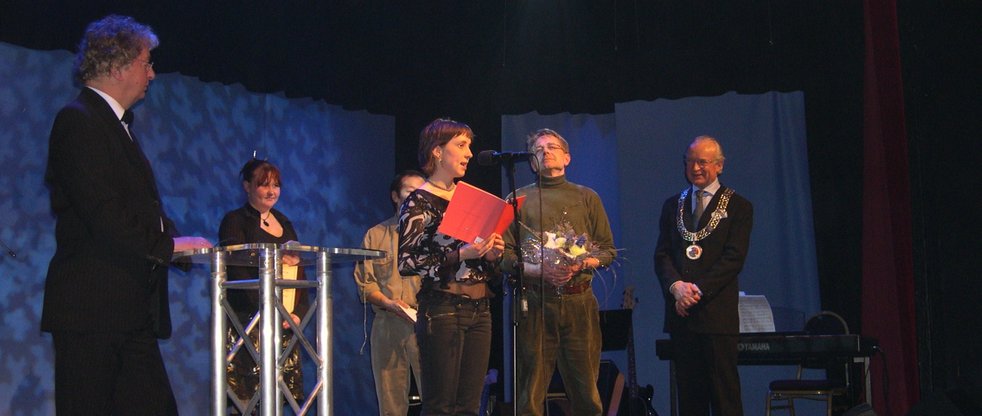Introduction in English
Amalie Skram’s House is a creative center for people who themselves recognize that they struggle with various psychological health issues in their daily life. Amalie Skrams house has a major focus on creative practices as part of processes of empowerment and recovery, along with a welcoming social milieu and physical activities outdoors. The house is very well equipped for offering workshops and training within the areas music, ceramics, textiles, glassworks, carpentry, graphics, drawings, painting and also photography. The house provides studio facilities as well as occasional literary workshops.
Importantly Amalie Skrams hus also offers many social events and represents a crucial meeting point and network of social support for many of our members and visitants. We may be speaking of "an urban extended family" with respect to the functioning of the network that Amalie Skrams hus makes up.
We also offer a programme for outdoor activities and physical exercize, in collaboration with local authorities and NGOs.
The activities of the house - from workshops to decision-making processes- are based on a strong sense of user participation in which the users of the house themselves lay down many of the premises for development and daily life activities.
Amalie Skram’s house took shape at the turn of the century - in the midst of a process in which the National Program of Mental Health passed through a pervasive reform and a paradigmatic shift in approach. This reform meant, among other things, the building down of monolithic and centralized psychiatric hospitals and a steady attention to individual adjustment and user participation in the programming of therapy.
This turn implied an increased focus on user participation in the process of recovery and a focus on the wholeness of the situation of the patient – that is, including attention to the social context in which someone became afflicted in the first place. The new paradigm involved the cooperation between the patient, the family, the patient's doctor, and District psychiatric Centers or polyclinic teams. The treatment regime should be adjusted to the particularities of the patient and his or her situation.
This also opened up the opportunity for experimentation with alternative initiatives in which emphasis were put on the resources and potential of persons rather than on their afflictions and problems. In this sense, Amalie Skram’s house represented at that time a quite radical alternative, born in the first place by way of the lobbying of a patient towards regional and local governments, and owing to the will among people such as Audun Pedersen (health bureaucrat and mentor of psychiatric health reform in Bergen) to listen to what he had to say about his experiences within mental health care. The house and the foundation were brought into existence on private initiative, and reached quickly support of municipal officials and regional and national authorities.
Amalie Skram’s house became a forerunner and a model for other similar initiatives and has also influenced the policy making and therapeutic shifts within psychiatric health care at a municipal level and also nationally. The house and foundation celebrated 10 years of existence in 2011. Contemporarily we have around 1000 visits each month – by users and members who engage in social activity and /or art work.
Who can become a user of the house - and what does membership imply?
Anyone who recognizes him- or herself as a person having experienced or currently experiencing psychological health problems, are welcome to use the house.During an initial period, it is normal for a potential member to test out what the house may offer in terms of facilities and opportunities. It is expected that a person may use the house for a while before considering being a member. A member must pay an annual fee of 100 NKr.
When becoming a member, you may use the house when no staff is present at what is termed "open for members". Only a group of selected persons may assume the responsibility of keeping the house open for others with no staff present.
A strong sense of user participation
A member also partakes more actively in meetings and in decision-making processes. We have a warm, dynamic and inclusive but also demanding environment, where members take an active part in shaping the house through weekly house meetings and member meetings.
Selected members also hold a majority of the votes at the board of Amalie Skrams hus, which is the highest decision-making organ.
One may say that the house operates in a dynamic of balance between what the individual wants and what the collectivity of the house needs; between staff and users of the house; between freedom, demands and expectations.
Ideology
The center focuses on what is healthy in people and not on their mental health as a problem. For this we do not ask about diagnosis, hospitalization or similar questions. We take the person at face value, focusing on life-enhancing practices in which creative activities and art work become means of empowerment and self fulfillment rather than therapy.
The ideology is one of discovering own potential, resources and own capabilities of growth through creative processes, whether these take place through individual labor or by taking part in group activities. We are focusing on the positive will and ability of the person in modifying and changing his or her situation, in which art work can be seen as a catalyst, as a road to life enhancement or as being an end in itself for artists and entrepreneurs.
Amalie Skram’s house is a place in which social sharing is crucial for the empowerment process. The users and members of the house put emphasis on the importance in their lives of the network, social interaction and feedback provided by others at the house. Many speak of reduction of loneliness and feelings of isolation. Being part of the house opens up a social world anew in which mutual aid is expected.
This is at once a place in which people can let their hair down, be themselves and meet acceptance from others sharing a similar situation. Simultaneously the users and members of the house and the employees direct expectations toward each other and also help each other out in daily life. Maybe one of the unique qualities of the house is the degree to which users and members of the house help each other out in times of problems and represent a correction to each other if someone is moving out of line, even to the extent that friends and sometimes also the staff may encourage others to seek professional psychiatric care if considered necessary.
Crucial to the ideology and practice of the house is that the users and members are expected, wanted and needed in the running of the daily activities at the center and in decision making processes. However, this is not an issue of therapy per se - it is basically a necessity for keeping the house open and running.
Staff
We have three permanent employees: a general manager, an artistic director, artistic staff and a music teacher.
The foundation Amalie Skrams hus
Amalie Skram’s house is a foundation, administered by a board consisting of seven members. Four members represent the house, and they have a strong impact on the decision making process and on operations. The members at the board are in a situation of majority when voting.
The foundation has employed a general manager in charge of the operations, economy and security of the house. Simultaneously the foundation places placing strong emphasis on user participation in decision making processes. What may seem as an organizational contradiction (on one side, a general manager and on the other side the majority situation at the board being capable of overriding the general manager in decision making) opts for careful balancing in decision making. Keeping a general manager employed implies a reality check in daily life and of the decisions taken. This is a challenging situation that demands negotiations but also firmness when needed. The house evolves through this dynamic.
Economical aspects
Amalie Skram’s house started up with a budget of 1.5 mill NKr and has now a budget of 3.2 mill. In purely economic terms, Amalie Skram’s house is very economic in the sense that it reduces the costs for local authorities. To give but one example:
Hospitalization is very expensive in Norway. The activities of the house and the social network provided by the members of the house may in many ways prevent long periods of repeated stays at district psychiatric centers for many. More importantly, the users and members live with a renewed sense of dignity, taking control over their situation.
Public recognition
Amalie Skram House was awarded a special prize for 2005 under a major arrangement at Ole Bull Scene 01/15/06. The award was presented by Mayor Hermann Friele as a confirmation of how the house helps to make life easier for many. The house has also received royal visits and receive visits from near and far weekly.


